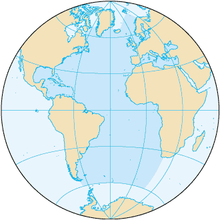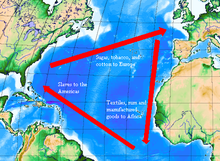This article needs additional citations for verification. (March 2010) |
Transatlantic relations refer to the historic, cultural, political, economic and social relations between countries on both side of the Atlantic Ocean. Sometimes it specifically means relationships between the Anglophone North American countries (the United States and Canada), and particular European countries or organizations, although other meanings are possible.

There are a number of issues over which the United States and Europe generally disagree. Some of these are cultural, such as the U.S. use of the death penalty, some are international issues such as the Middle East peace process where the United States is often seen as pro-Israel and where Europe is often seen as pro-Arab (or at least neutral), and many others are trade related. The current U.S. policies are often described as being unilateral in nature, whereas the European Union and Canada are often said to take a more multilateral approach, relying more on the United Nations and other international institutions to help solve issues. There are many other issues upon which they agree.[1]
Definition edit


Transatlantic relations can refer to relations between individual states or to relations between groups of states or international organizations with other groups or with states, or within one group.For example:
Within a group:
- Intra-NATO relations
Between groups:
- EU - North American Free Trade Agreement (NAFTA) relations
- European Free Trade Area (EFTA) - NAFTA relations
- Transatlantic Free Trade Area (theoretical)
- CARIFORUM - European Commission (Economic Partnership Agreements)
Between a group and a state:
- Canada–European Union relations
- United States–European Union relations
- Canada - EFTA Free Trade Agreement [2][3]
Between states:
By language and culture
- Commonwealth of Nations
- Community of Portuguese Language Countries
- Dutch Union
- La Francophonie
- Latin Union
The boundaries of which states are part of Transatlantic relations depends on the context. The term may be used as a euphemism to a specific bilateral relationship, for example, Anglo-American relations. The boundary could be drawn so as only to refer member states of the EU plus the US, when discussing Euro-American relations. In other circumstances it may include Canada, or non-EU countries in Europe. The term may also be used in the context of the wider Atlantic world including Africa and Latin America.
History edit

The early relationship between Europe and America was based on colonialism and mercantilism. The majority of modern states in the Americas can be traced back to colonial states that were founded by European nations, states that were very different from the pre-Columbian civilizations and cultures that had existed before.
Even after the United States (and later Canada) became independent, the main relationship between the two continents was one-way migration.
Politically the United States tried to keep a distance from European affairs, and Canada was subordinate to British foreign policy.
During the First World War however both North American states found themselves fighting in Europe and engrossed in European politics. President Woodrow Wilson's Fourteen Points helped to redraw the map of Europe.
Although the Roosevelt administration wanted to enter the war against Germany, the vast majority of Americans were too isolationist and disillusioned at their experience in World War I to seek involvement in the World War II, at least until the U.S. was attacked by Japan at Pearl Harbor on December 7, 1941, and Adolf Hitler declared war on the United States on December 11, 1941. Once involved, the US became pivotal to the war effort and therefore European politics.
After the second war the United States and Canada both desired a permanent role in the defence of Europe, and European states wanted protection from the Soviet Union. The result was the North Atlantic Treaty Organization, which became the lynchpin of Transatlantic relations during the Cold War.[1]
Atlanticism is a philosophy which advocates for close cooperation between North America and Europe.
 European Union European Union(in respect of its defence arm, the Common Security and Defence Policy) |  NATO NATO | ||
|---|---|---|---|
| Mutual defence clause | Article 42.7 of the consolidated version of the Treaty on European Union: "If a Member State is the victim of armed aggression on its territory, the other Member States shall have towards it an obligation of aid and assistance by all the means in their power, in accordance with Article 51 of the United Nations Charter. This shall not prejudice the specific character of the security and defence policy of certain Member States. [...]" | Article 5 of the North Atlantic Treaty: "The Parties agree that an armed attack against one or more of them [on their territory] shall be considered an attack against them all and consequently they agree that, if such an armed attack occurs, each of them, in exercise of the right of individual or collective self-defence recognised by Article 51 of the Charter of the United Nations, will assist the Party or Parties so attacked by taking forthwith, individually and in concert with the other Parties, such action as it deems necessary, including the use of armed force, to restore and maintain the security of the North Atlantic area. [...]" | |
| Political strategic organisation | |||
| Highest office | High Representative (HR/VP) | Secretary General | |
| Principal decision-making body | Foreign Affairs Council | North Atlantic Council | |
| Liaison body | European External Action Service | International Staff | |
| Seat | Kortenberg building (Brussels, Belgium) |  NATO headquarters (Brussels, Belgium) NATO headquarters (Brussels, Belgium) | |
| Military strategic organisation | |||
| Supreme commander |     Director of the Military Planning and Conduct Capability Director of the Military Planning and Conduct Capability |      Supreme Allied Commander Europe Supreme Allied Commander Europe | |
| Headquarters |  Military Planning and Conduct Capability (Brussels, Belgium) Military Planning and Conduct Capability (Brussels, Belgium) |  Supreme Headquarters Allied Powers Europe (Mons, Belgium) Supreme Headquarters Allied Powers Europe (Mons, Belgium) | |
| Chair of chiefs of defence assembly |      Chairman of the European Union Military Committee Chairman of the European Union Military Committee |      Chair of the NATO Military Committee Chair of the NATO Military Committee | |
| Chiefs of defence assembly |  European Union Military Committee European Union Military Committee |  NATO Military Committee NATO Military Committee | |
| Advisory body |  European Union Military Staff European Union Military Staff |  International Military Staff International Military Staff | |
| Membership | Permanent Structured Cooperation | Membership | |
| Member states of both the EU and NATO | |||
 Belgium Belgium | Founder | Founder | Founder |
 Bulgaria Bulgaria | 2007 | Founder | 2004 |
 Croatia Croatia | 2013 | Founder | 2009 |
 Czech Republic Czech Republic | 2004 | Founder | 1999 |
 Denmark Denmark | 1973 | 2023 | Founder |
 Estonia Estonia | 2004 | Founder | 2004 |
 Finland Finland | 1995 | Founder | 2023 |
 France France | Founder | Founder | Founder |
 Germany Germany | Founder | Founder | 1955 |
 Greece Greece | 1981 | Founder | 1952 |
 Hungary Hungary | 2004 | Founder | 1999 |
 Italy Italy | Founder | Founder | Founder |
 Latvia Latvia | 2004 | Founder | 2004 |
 Lithuania Lithuania | 2004 | Founder | 2004 |
 Luxembourg Luxembourg | Founder | Founder | Founder |
 Netherlands Netherlands | Founder | Founder | Founder |
 Poland Poland | 2004 | Founder | 1999 |
 Portugal Portugal | 1986 | Founder | Founder |
 Romania Romania | 2007 | Founder | 2004 |
 Slovakia Slovakia | 2004 | Founder | 2004 |
 Slovenia Slovenia | 2004 | Founder | 2004 |
 Spain Spain | 1986 | Founder | 1982 |
 Sweden Sweden | 1995 | Founder | 2024 |
| Non-NATO EU member states | |||
 Austria Austria | 1995 | Founder | Partnership for Peace |
 Cyprus Cyprus | 2004 | Founder | No |
 Ireland Ireland | 1973 | Founder | Partnership for Peace |
 Malta Malta | 2004 | No | Partnership for Peace |
| Non-EU NATO member states | |||
 Albania Albania | Candidate | — | 2009 |
 Iceland Iceland | No | — | Founder |
 Montenegro Montenegro | Candidate | — | 2017 |
 North Macedonia North Macedonia | Candidate | — | 2020 |
 Norway Norway | Defence Agency agreement | — | Founder |
 Turkey Turkey | Candidate | — | 1952 |
 United Kingdom United Kingdom | No | — | Founder |
| European countries outside both the EU and NATO | |||
 Andorra Andorra | No | — | No |
 Armenia Armenia | No | — | Individual Partnership Action Plan |
 Azerbaijan Azerbaijan | No | — | Individual Partnership Action Plan |
 Belarus Belarus | No | — | Partnership for Peace |
 Bosnia and Herzegovina Bosnia and Herzegovina | Candidate | — | Membership Action Plan |
 Georgia Georgia | Applicant / Potential candidate | — | Intensified Dialogue |
 Kazakhstan Kazakhstan | No | — | Individual Partnership Action Plan |
 Kosovo Kosovo | Applicant / Potential candidate | — | No |
 Liechtenstein Liechtenstein | No | — | No |
 Moldova Moldova | Candidate | — | Individual Partnership Action Plan |
 Monaco Monaco | No | — | No |
 Russia Russia | No | — | Partnership for Peace |
 San Marino San Marino | No | — | No |
 Serbia Serbia | Candidate | — | Individual Partnership Action Plan |
 Switzerland Switzerland | Defence Agency agreement | — | Partnership for Peace |
 Ukraine Ukraine | Candidate | — | Intensified Dialogue |
 Vatican City Vatican City | No | — | No |
| NATO member states located in North America, which are therefore ineligible for EU membership | |||
 Canada Canada | — | — | Founder |
 United States United States | — | — | Founder |
| Members of NATO's Partnership for Peace located outside Europe, which are therefore neither eligible for EU nor NATO membership | |||
 Kyrgyzstan Kyrgyzstan | — | — | Partnership for Peace |
 Tajikistan Tajikistan | — | — | Partnership for Peace |
 Turkmenistan Turkmenistan | — | — | Partnership for Peace |
 Uzbekistan Uzbekistan | — | — | Partnership for Peace |
See also edit
- Atlanticism
- Atlantic Community
- Atlantic Council
- Atlantic history
- United States–European Union relations
- European Union–NATO relations
- German Marshall Fund
- South Atlantic Peace and Cooperation Zone
- Transatlantic Economic Council
- Transatlantic Free Trade Area (TAFTA)
- Canada–European Union relations
- Canada–NATO relations
- Western World
References edit
- ^ a b Portero, Florentino (May 29, 2002). "Las relaciones transatlánticas" (in Spanish). Madrid: Elcano Royal Institute. Retrieved April 11, 2021.
- ^ EFTA Archived 2008-04-22 at the Wayback Machine
- ^ "Foreign Affairs Department, Canada". Archived from the original on 2011-05-20. Retrieved 2008-03-20.
Bibliography edit
- Jussi M. Hanhimaki, Benedikt Schoenborn and Barbara Zanchetta, "Transatlantic Relations since 1945. An Introduction", Routledge, London, 2012.
External links edit

- A stronger EU-US Partnership and a more open market for the 21st century[permanent dead link]
- European Union Institute for Security Studies: The Obama Moment - European and American Perspectives
- Atlantic Council of the U.S.: Transatlantic Cooperation Against Terrorism
- Atlantic Council publications on transatlantic economics, security, and politics
- "The Invisible Pillar of Transatlantic Cooperation: Activating Untapped Science & Technology Assets," Science & Diplomacy
- R. Nicholas Burns, Under Secretary of State for Political Affairs, called on the U.S. and Europe to embrace common purpose around an ambitious global agenda that would redefine its mission for the 21st Century.
- Center for Transatlantic Relations Archived 2014-11-27 at the Portuguese Web Archive